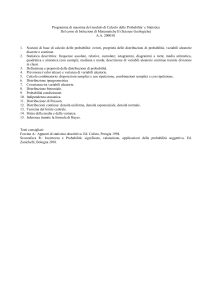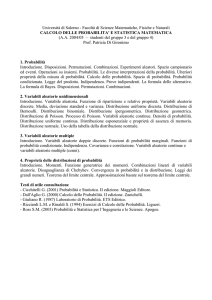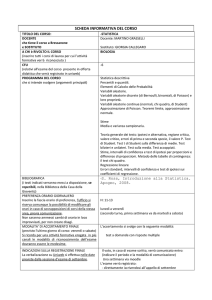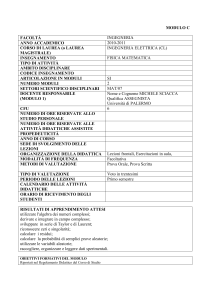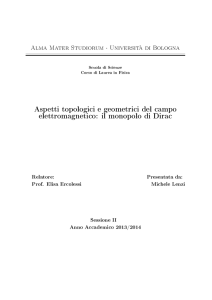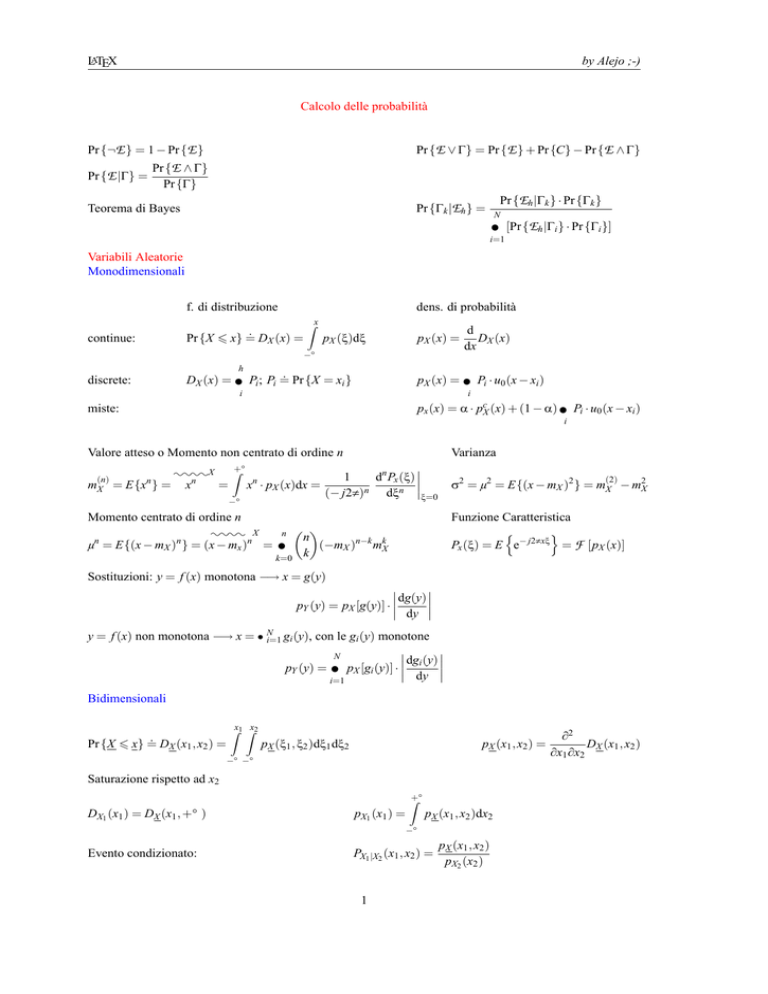
LATEX
by Alejo ;-)
Calcolo delle probabilità
Pr {E ∨ Γ} = Pr {E } + Pr {C} − Pr {E ∧ Γ}
Pr {¬E } = 1 − Pr {E }
Pr {E |Γ} =
Pr {E ∧ Γ}
Pr {Γ}
Pr {Γk |Eh } =
Teorema di Bayes
Pr {Eh |Γk } · Pr {Γk }
N
∑ [Pr {Eh |Γi } · Pr {Γi }]
i=1
Variabili Aleatorie
Monodimensionali
f. di distribuzione
continue:
dens. di probabilità
.
Pr {X 6 x} = DX (x) =
Zx
pX (ξ)dξ
pX (x) =
−∞
h
discrete:
.
DX (x) = ∑ Pi ; Pi = Pr {X = xi }
d
DX (x)
dx
pX (x) = ∑ Pi · u0 (x − xi )
i
i
px (x) = α · pcX (x) + (1 − α) ∑ Pi · u0 (x − xi )
miste:
i
Valore atteso o Momento non centrato di ordine n
(n)
mX = E{xn } =
::::X
xn
=
Varianza
Z+∞
−∞
dn Px (ξ) 1
n
x · pX (x)dx =
(− j2π)n dξn ξ=0
Momento centrato di ordine n
:::: X
µn = E{(x − mX )n } = (x − mx )n =
(2)
σ2 = µ2 = E{(x − mX )2 } = mX − m2X
Funzione Caratteristica
n
o
Px (ξ) = E e− j2πxξ = F [pX (x)]
n
n
∑ k (−mX )n−k mkX
k=0
Sostituzioni: y = f (x) monotona −→ x = g(y)
dg(y) pY (y) = pX [g(y)] · dy y = f (x) non monotona −→ x = ∑Ni=1 gi (y), con le gi (y) monotone
N
dgi (y) pY (y) = ∑ pX [gi (y)] · dy i=1
Bidimensionali
.
Pr {X 6 x} = DX (x1 , x2 ) =
Zx1 Zx2
pX (ξ1 , ξ2 )dξ1 dξ2
pX (x1 , x2 ) =
−∞ −∞
Saturazione rispetto ad x2
Z+∞
DX1 (x1 ) = DX (x1 , +∞)
pX1 (x1 ) =
pX (x1 , x2 )dx2
−∞
Evento condizionato:
PX1 |X2 (x1 , x2 ) =
1
pX (x1 , x2 )
pX2 (x2 )
∂2
DX (x1 , x2 )
∂x1 ∂x2
LATEX
by Alejo ;-)
Momento non centrato di ordine (h, k):
(h,k)
mX
n
o Z+∞Z+∞
h k
= E x1 · x2 =
x1h · x2k pX (x1 , x2 )dx1 dx2
−∞ −∞
(h,0)
mX
(h)
(0,k)
= mX1
(k)
= mX2
n
o
µ(h,k) = E (x1 − mX1 )h (x2 − mX2 )k
mX
Momenti centrati di ordine (h, k):
(1,1)
(1,1)
σ1,2 = µX = mX
σ1,2
ρ1,2 =
σ1 · σ2
covarianza:
Coefficiente di correlazione:
Cambiamento di variabile aleatoria
(
y1 = f1 (x1 , x2 )
y2 = f2 (x1 , x2 )
(
x1 = g1 (y1 , y2 )
x2 = g2 (y1 , y2 )
=⇒
pY (y1 , y2 ) = pX [g1 (y1 , y2 ), g2 (y1 , y2 )] ||J(y1 , y2 )||
Matrice di Covarianza:
σ1,1
σ2,1
..
.
σn,1
− mX1 · mX2
J(y1 , y2 ) =
σ1,2
σ2,2
..
.
···
···
..
.
σn,2
···
σi, j = E (xi − mxi )(x j − mx j )
∂g1
∂y1
∂g1
∂y2
∂g2
∂y1
∂g2
∂y2
!
σ1,n
σ2,n
..
.
σn,m
σi, j = σ j,i
σii = σ2Xi
Indipendenza Statistica
Se E e Γ sono statisticamente indipendenti allora:
Pr {E |Γ} = Pr {E }
Pr {Γ|E } = Pr {Γ}
Pr {E ∧ Γ} = Pr {E } · Pr {Γ}
pX (x1 , x2 ) = pX1 (x1 ) · pX2 (x2 )
DX (x1 , x2 ) = DX1 (x1 ) · DX2 (x2 )
(h,k)
mX
µX
(h)
(k)
= mX1 · mX2
(h,k)
(h)
(k)
= µX1 · µX2
Combinazione lineare di n variabili aleatorie
Y = a1 · X1 + a2 · X2 + . . . + an · Xn
1
y
y
y
pY (y) =
pX
∗ pX2
∗ . . . ∗ pXn
|a1 · a2 . . . an | 1 a1
a2
an
n
n
n
n
σY2 = ∑ ∑ ai · a j · σXi X j =−−−−→ ∑ a2i · σ2Xi
i=1 j=1
stat. ind.
mY = ∑ ai · mXi
i
i
2
LATEX
by Alejo ;-)
Gaussiana
Monodimensionale
1
x − mX
DX x = 1 − erfc √
2
2σ
(x−mX )2
1
pX (x) = √
e− 2σ
2π σ
(n)
µX
(
0
=
1 · 3 · 5 · (n − 1)σnX
, n dispari
, n pari
n-dimensionale
pX (x) =
(2π)n/2
1
T −1
exp − (x − mX ) KX (x − mX )
2
det [Kx ]
1
p
F [pX (x)] = PX ( f ) = e− j2πξ
(1,1,1,1)
µX
(1,1,1)
(1,1,1,1)
mX −2πξT Kx ξ
e
= E {(x1 − mX1 )(x2 − mX2 )(x3 − mX3 )(x4 − mX4 )} = σX1 X2 · σX3 X4 + σX1 X3 · σX2 X4 + σX1 X4 σX2 X3
µX
mX
T
= E {(x1 − mX1 )(x2 − mX2 )(x3 − mX3 )} = 0
:::: X1 ,X2 ,X3 ,X4 ::::X1 ,X2 ::::X3 ,X4 ::::X1 ,X3 ::::X2 ,X4 ::::X1 ,X4 ::::X2 ,X3
= x1 x2 x3 x4
= x1 x2
· x3 x4
+ x1 x3
· x2 x4
+ x1 x4
· x2 x3
Bidimensionale
pX,Y (x, y) =
2πσX σY
1
p
1 − ρ2
exp −
(x − mX )2 2ρ(x − mX )(y − my ) (y − mY )2
1
−
+
2(1 − ρ2 )
σX σY
σY
σ2X
Variabili aleatorie condizionate
mX|Y = mX + ρ
σX
(y − my )
σY
σ2X|Y = σX (1 − ρ2 )
Distribuzione di Bernouilli
pX (x) = P0 · u0 (x) + P1 · u0 (x − 1)
B = X1 + X2 + . . . + Xn
n
n
n!
=
l
l!(n − l)!
mB = n · P1
σ2B = n · P0 · P1
n n−l l
pB (b) = ∑
P0 · P1 · u0 (b − l)
l=0 l
3






